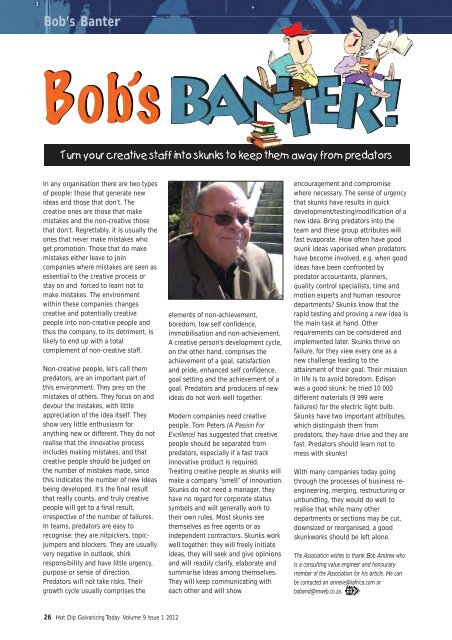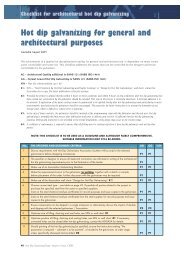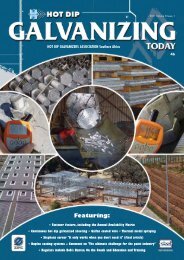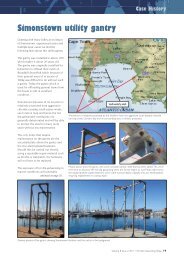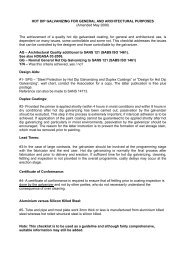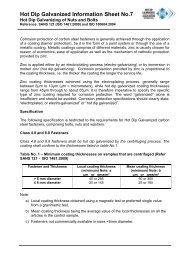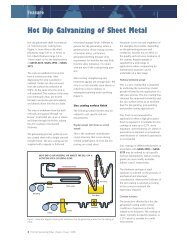Fasteners - hdgasa
Fasteners - hdgasa
Fasteners - hdgasa
You also want an ePaper? Increase the reach of your titles
YUMPU automatically turns print PDFs into web optimized ePapers that Google loves.
Bob’s Banter<br />
Turn your creative staff into skunks to keep them away from predators<br />
In any organisation there are two types<br />
of people: those that generate new<br />
ideas and those that don’t. The<br />
creative ones are those that make<br />
mistakes and the non-creative those<br />
that don’t. Regrettably, it is usually the<br />
ones that never make mistakes who<br />
get promotion. Those that do make<br />
mistakes either leave to join<br />
companies where mistakes are seen as<br />
essential to the creative process or<br />
stay on and forced to learn not to<br />
make mistakes. The environment<br />
within these companies changes<br />
creative and potentially creative<br />
people into non-creative people and<br />
thus the company, to its detriment, is<br />
likely to end up with a total<br />
complement of non-creative staff.<br />
Non-creative people, let’s call them<br />
predators, are an important part of<br />
this environment. They prey on the<br />
mistakes of others. They focus on and<br />
devour the mistakes, with little<br />
appreciation of the idea itself. They<br />
show very little enthusiasm for<br />
anything new or different. They do not<br />
realise that the innovative process<br />
includes making mistakes, and that<br />
creative people should be judged on<br />
the number of mistakes made, since<br />
this indicates the number of new ideas<br />
being developed. It’s the final result<br />
that really counts, and truly creative<br />
people will get to a final result,<br />
irrespective of the number of failures.<br />
In teams, predators are easy to<br />
recognise: they are nitpickers, topicjumpers<br />
and blockers. They are usually<br />
very negative in outlook, shirk<br />
responsibility and have little urgency,<br />
purpose or sense of direction.<br />
Predators will not take risks. Their<br />
growth cycle usually comprises the<br />
elements of non-achievement,<br />
boredom, low self confidence,<br />
immobilisation and non-achievement.<br />
A creative person’s development cycle,<br />
on the other hand, comprises the<br />
achievement of a goal, satisfaction<br />
and pride, enhanced self confidence,<br />
goal setting and the achievement of a<br />
goal. Predators and producers of new<br />
ideas do not work well together.<br />
Modern companies need creative<br />
people. Tom Peters (A Passion For<br />
Excellence) has suggested that creative<br />
people should be separated from<br />
predators, especially if a fast track<br />
innovative product is required.<br />
Treating creative people as skunks will<br />
make a company “smell” of innovation.<br />
Skunks do not need a manager, they<br />
have no regard for corporate status<br />
symbols and will generally work to<br />
their own rules. Most skunks see<br />
themselves as free agents or as<br />
independent contractors. Skunks work<br />
well together: they will freely initiate<br />
ideas, they will seek and give opinions<br />
and will readily clarify, elaborate and<br />
summarise ideas among themselves.<br />
They will keep communicating with<br />
each other and will show<br />
encouragement and compromise<br />
where necessary. The sense of urgency<br />
that skunks have results in quick<br />
development/testing/modification of a<br />
new idea. Bring predators into the<br />
team and these group attributes will<br />
fast evaporate. How often have good<br />
skunk ideas vaporised when predators<br />
have become involved, e.g. when good<br />
ideas have been confronted by<br />
predator accountants, planners,<br />
quality control specialists, time and<br />
motion experts and human resource<br />
departments? Skunks know that the<br />
rapid testing and proving a new idea is<br />
the main task at hand. Other<br />
requirements can be considered and<br />
implemented later. Skunks thrive on<br />
failure, for they view every one as a<br />
new challenge leading to the<br />
attainment of their goal. Their mission<br />
in life is to avoid boredom. Edison<br />
was a good skunk: he tried 10 000<br />
different materials (9 999 were<br />
failures) for the electric light bulb.<br />
Skunks have two important attributes,<br />
which distinguish them from<br />
predators; they have drive and they are<br />
fast. Predators should learn not to<br />
mess with skunks!<br />
With many companies today going<br />
through the processes of business reengineering,<br />
merging, restructuring or<br />
unbundling, they would do well to<br />
realise that while many other<br />
departments or sections may be cut,<br />
downsized or reorganised, a good<br />
skunkworks should be left alone.<br />
The Association wishes to thank Bob Andrew who<br />
is a consulting value engineer and honourary<br />
member of the Association for his article. He can<br />
be contacted on anneve@iafrica.com or<br />
boband@mweb.co.za.<br />
26 Hot Dip Galvanizing Today Volume 9 Issue 1 2012


